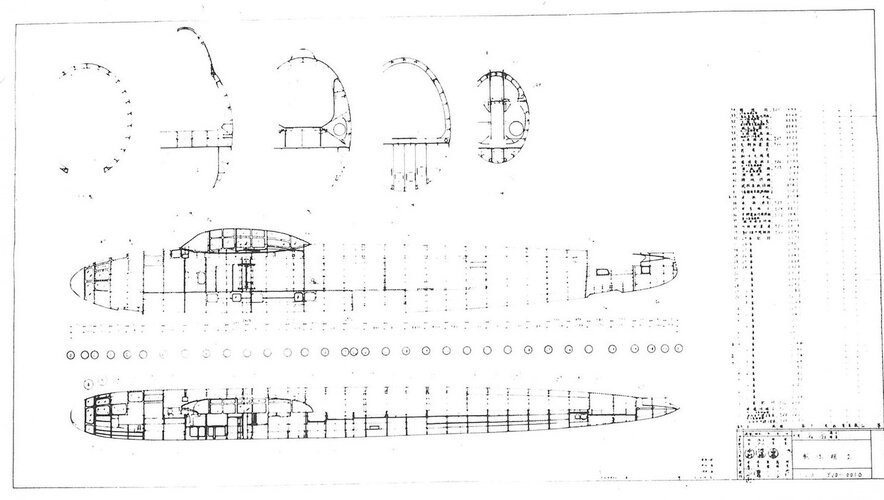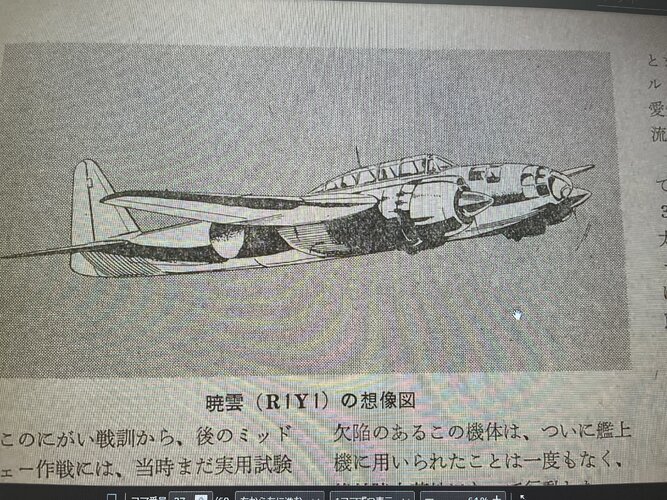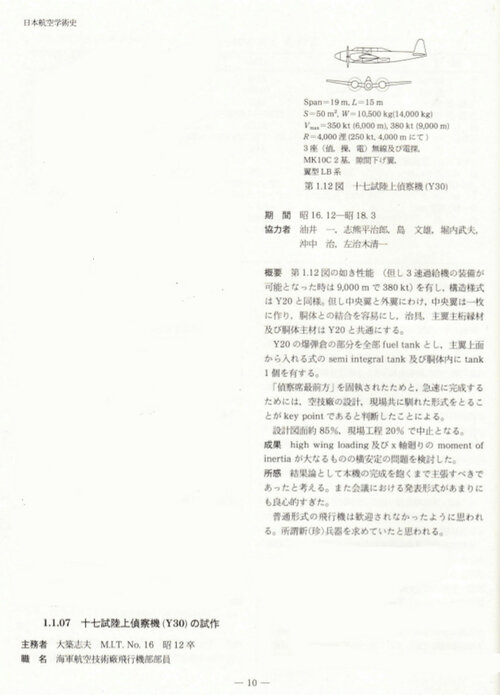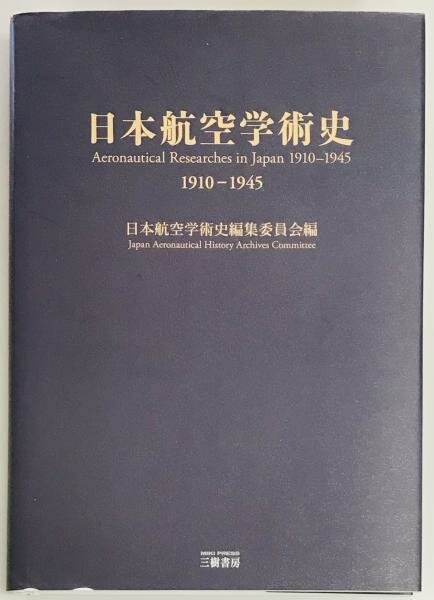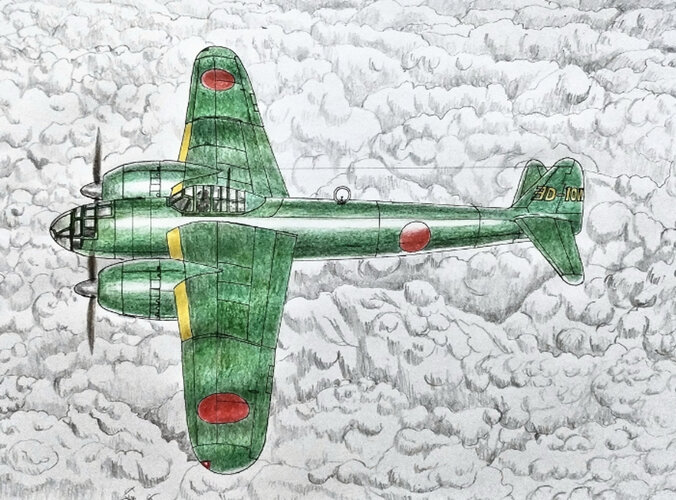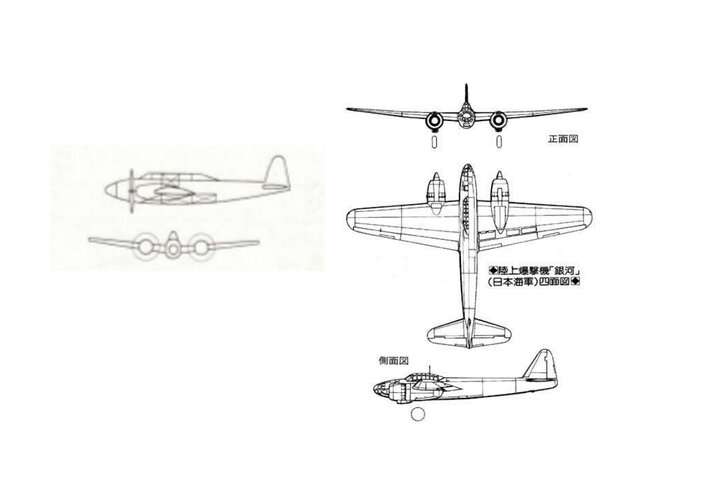Ginga variants and projects
The Yokosuka P1Y1 was designed in 1940, following a specification of the IJN clearly inspired by the Junkers Ju 88. The P1Y1 turned out to be a complex and difficult to maintain aircraft that only came into service when the war was lost for Japan.
Forced by circumstances to make long journeys over the sea with some unreliable engines, all missions of the Frances had some suicidal quality. These bombers were so valuable to the IJN that the decision to carry out a conventional or suicidal attack was left up to each pilot, depending on the circumstances of each combat. The first Tokko attack was made by a Frances in flames that had been reached by the AA, against the destroyer USS Ammen (DD-527) in Leyte Gulf, on November 11, 1944. On the 15th of the same month, the first Reppu suicide unit was formed, with aircraft from the 763rd Kokutai.
On the 25th, six airplanes of the Shippu and Kyofu units made the first suicide attack on an Allied Task Force, 15 nm off Manila. Several Frances were shot down by the Hellcats of the aircraft carriers USS Ticonderoga and USS Essex, but an aircraft of the Kyofu-Tai, loaded with two bombs of 507 kg, impacted the aircraft carrier USS Intrepid (CV-11) east of Lamon Bay. On March 11, 24 P1Y1 bombers of the Azusa Special Attack Unit, from the 762nd Kokutai, were guided by a Kawanishi Emily flying boat, flying during 12 hours, heavily loaded with two detachable fuel tanks of 600 lt and a bomb of 807.5 kg, in order to attack the US naval base at Ulithi Atoll.
Most of these aircraft were forced to abort the attack because of engine problems and adverse winds. Only two of them reached Ulithi and one impacted the aircraft carrier USS Randolph (CV-15) damaging the flying deck. On March 18, ten aircraft of the Ginga Unit again damaged the USS Intrepid, east of Kyushu. On May 7, another nineteen Frances of the 4th Mitate Tokubetsu Kogekitai were forced to abort Operation Tan No. 3 that was to be a second attack against Ulithi, again due to engine failures. On the 25th, three aircraft of the Ginga Unit No. 10 managed to sink the destroyer USS Bates (DE-68), 2 nm south of Le Shima.
Between November 14, 1944 and May 25, 1945, no less than 218 Frances of the suicide units Reppu, Shippu, Kyofu, Doto, Gufu, Kusanagi, Mitate, Ginga, Azusa, Yubu and 501st Special Attack Squadron, carried out attacks against Allied ships and airfields in Lamon Bay, Kossol Roads, Leyte, Sulu Sea, Davao, Okinawa, Leyushu, Ryukyu Islands, Kikai Islands, Ulithi Atoll and Taiwan.
In the summer of 1944, a certain number of aircraft of the P1Y2-S Kyokko type entered service with the 302nd Kokutai. They had been specially modified as night fighters to operate against the B-29s, but the experiment was a failure because the Kyokko lacked the ceiling to reach the Superfortress due to the poor performance of its new engines Kasei 25a. The slightly different version P1Y1 Byokko that was manufactured by Nakajima, was also not very successful and the IJN ordered all night fighters were retrofitted to the bomber role.
In July 1945, the first flight tests of the Mukade were conducted in the Arsenal of Yokosuka. The Mukade was a modification of the Frances specialized in long range strafing role against the US bases of B-29s. The project was inspired by the ventral armament of the Irving and consisted of twelve 20 mm cannons angled at 30 degree downwards and fired from an altitude of 200 m over the rows of refuelled and bombed-up B-29s. It was hoped that a fireball effect would take place with entire ranks of Superfortress blowing each other up.
The Mukade tactics were part of the Operation Ken-Go consisting of attempting an attack against the USAAF base at Iwo Jima using thirty six Frances of the Mitate Unit No. 6, thirty six Mukade and thirty G4M bombers that had been modified for transporting suicide commands. There was also the project of the P1Y3 Mod.33, a Frances with enlarged fuselage and extended wingspan specially modified as a mother ship for the Ohka Mod.22 jet bomber.
-Night Fighters
Yokosuka Ginga, Kawanishi Kyokko, Nakajima Byakko and Kugisho Tenga
The Yokosuka P1Y1 Ginga was designed in 1940, following a specification of the IJN (clearly inspired by the Junkers Ju 88) requiring a fast bomber that would be suitable for dive-bombing and low-altitude torpedo attack.
On March 1945 some units of the P1Y1 Model 11 of the 762nd Kokutai were equipped with an H-6 ASV radar to perform nigh attacks against U.S. Navy ships. The P1Y was tested in alternative roles.
Early in 1944 the Kawanishi Company was instructed by the Kaigun Koku Hombu to produce a night fighter variant under the designation P1Y2-S Kyokko Model 26. The new planes would be powered by two 1,850 hp Mitsubishi MK4T-A Kasei 25a radial engines, that were considered safer than the Homare 12 del Ginga, and armed with a
Type 5, 30 mm cannon angled at 35 degree in Schräge Musik configuration. The prototype flew in June 1944 and Kawanishi modified a total of 96 Ginga airframes.
Between March and November of 1944, a certain number of Kyokko entered into service with the Kokutais Nos. 302 and 321, but they were not successful against the B-29s. The low speed of 523 kph and the service ceiling of 9,400 m only proved disappointing. The plan was to install the FD-2 AI radar in the series version.
Kakajima also built the P1Y1-S Byakko night fighter, a Ginga armed with two Type 99-2, 20 mm cannons, angled at 30 degree in Schräge Musik configuration. In the summer of 1945, the P1Y1-S performed operational tests with the 302nd Kokutai basedo in Atsugi. Byakko performed better than Kyokko but also did not enter service. At least one P1Y1-S was equipped with a H-5/FD-1 AI radar, an experimental version of the H-6 ASV with Yagi antenna, that had been specially designed to generate less drag in the nose.
In July 1945, the first flight tests of the Mukade conversion were conducted in the Arsenal of Yokosuka. The Mukade was a modification of the Ginga specialized in long range strafing role against the US bases of B-29s. The project was inspired by the ventral armament of the Gekko and consisted of twelve 20 mm cannons angled at 30 degree downwards and fired from an altitude of 200 m over the rows of refuelled and bombed-up B-29s. It was hoped that a fireball effect would take place with entire ranks of Superfortress blowing each other up.
The Mukade tactics were part of the Operation Ken-Go consisting of attempting an attack against the USAAF base at Iwo Jima using thirty-six Gingas of the Mitate Unit No.6, thirty-six Mukade and thirty G4M bombers that had been modified for transporting suicide commands. There was also the project of the P1Y3 Mod.33, a Ginga with enlarged fuselage and extended wingspan specially modified as a mother ship for the Ohka Mod.22 jet bomber. The Model 33 did not go beyond the drawing board.
After the Battle of the Coral Sea in May 1942 the IJN admitted the need to have a ground based fast reconnaissance airplane. Little afterwards, the Naval Air Arsenal at Yokosuka received the specification 17 Shi to design an aircraft that could fly at 666 kph at an altitude of 6,000 m. Under the project name Y-30, it was assigned to two teams that would study the different possibilities of a single or a twin-engine airplane.
The R1Y1 Seiun would have had a classic airframe and been propelled by a Mitsubishi 24-cylinder, liquid cooled, 2,500 hp experimental engine. The R1Y2 Gyoun would be an evolution from the Ginga with two Mitsubishi Mk10A (Ha-214) 2,400 hp radial engines. The Seiun engine did not prove to be acceptable on the medium term and the estimated performance of the Gyoun showed that it did not comply with the requirements of the 17 Shi. Dr. Masao Yamana, of Kugisho, suggested the use of German inline engines, paired inside the fuselage, to build the R2Y1 Keiun with a single nose propeller and long power shaft. The formula did not work and the team of Kugisho proposed to the IJN its transformation into a suicide fast bomber with two Ne-30 turbojets.
The opportunity to have these new engines reactivated the Gyoun, using a Yokosuka P1Y1 Ginga as a prototype, propelled by the two turbojets under the wing nacelles. The final model was known as Tenga and would have probably been propelled by two Ne-130 turbojets with a power equivalent to that of a German Jumo 004. The most important modifications, compared to the Ginga series, included the adoption of a solid nose cone and the installation of the main undercarriage legs between the engines and the fuselage.
Tenga speculative technical data
Wingspan: 20 m, length: 15 m, height: 4.30 m, wing area: 55 sq.m, max weight: 10,500 kg, estimated max speed: 700-750 kph, estimated service ceiling: over 10,000 m, engines: two Ne-30 centrifugal turbojets with 850 kgf peak thrust or two Ne-130 axial turbojets with 900 kgf peak thrust.
The Yokosuka P1Y1 was designed in 1940, following a specification of the IJN clearly inspired by the Junkers Ju 88. The P1Y1 turned out to be a complex and difficult to maintain aircraft that only came into service when the war was lost for Japan.
Forced by circumstances to make long journeys over the sea with some unreliable engines, all missions of the Frances had some suicidal quality. These bombers were so valuable to the IJN that the decision to carry out a conventional or suicidal attack was left up to each pilot, depending on the circumstances of each combat. The first Tokko attack was made by a Frances in flames that had been reached by the AA, against the destroyer USS Ammen (DD-527) in Leyte Gulf, on November 11, 1944. On the 15th of the same month, the first Reppu suicide unit was formed, with aircraft from the 763rd Kokutai.
On the 25th, six airplanes of the Shippu and Kyofu units made the first suicide attack on an Allied Task Force, 15 nm off Manila. Several Frances were shot down by the Hellcats of the aircraft carriers USS Ticonderoga and USS Essex, but an aircraft of the Kyofu-Tai, loaded with two bombs of 507 kg, impacted the aircraft carrier USS Intrepid (CV-11) east of Lamon Bay. On March 11, 24 P1Y1 bombers of the Azusa Special Attack Unit, from the 762nd Kokutai, were guided by a Kawanishi Emily flying boat, flying during 12 hours, heavily loaded with two detachable fuel tanks of 600 lt and a bomb of 807.5 kg, in order to attack the US naval base at Ulithi Atoll.
Most of these aircraft were forced to abort the attack because of engine problems and adverse winds. Only two of them reached Ulithi and one impacted the aircraft carrier USS Randolph (CV-15) damaging the flying deck. On March 18, ten aircraft of the Ginga Unit again damaged the USS Intrepid, east of Kyushu. On May 7, another nineteen Frances of the 4th Mitate Tokubetsu Kogekitai were forced to abort Operation Tan No. 3 that was to be a second attack against Ulithi, again due to engine failures. On the 25th, three aircraft of the Ginga Unit No. 10 managed to sink the destroyer USS Bates (DE-68), 2 nm south of Le Shima.
Between November 14, 1944 and May 25, 1945, no less than 218 Frances of the suicide units Reppu, Shippu, Kyofu, Doto, Gufu, Kusanagi, Mitate, Ginga, Azusa, Yubu and 501st Special Attack Squadron, carried out attacks against Allied ships and airfields in Lamon Bay, Kossol Roads, Leyte, Sulu Sea, Davao, Okinawa, Leyushu, Ryukyu Islands, Kikai Islands, Ulithi Atoll and Taiwan.
In the summer of 1944, a certain number of aircraft of the P1Y2-S Kyokko type entered service with the 302nd Kokutai. They had been specially modified as night fighters to operate against the B-29s, but the experiment was a failure because the Kyokko lacked the ceiling to reach the Superfortress due to the poor performance of its new engines Kasei 25a. The slightly different version P1Y1 Byokko that was manufactured by Nakajima, was also not very successful and the IJN ordered all night fighters were retrofitted to the bomber role.
In July 1945, the first flight tests of the Mukade were conducted in the Arsenal of Yokosuka. The Mukade was a modification of the Frances specialized in long range strafing role against the US bases of B-29s. The project was inspired by the ventral armament of the Irving and consisted of twelve 20 mm cannons angled at 30 degree downwards and fired from an altitude of 200 m over the rows of refuelled and bombed-up B-29s. It was hoped that a fireball effect would take place with entire ranks of Superfortress blowing each other up.
The Mukade tactics were part of the Operation Ken-Go consisting of attempting an attack against the USAAF base at Iwo Jima using thirty six Frances of the Mitate Unit No. 6, thirty six Mukade and thirty G4M bombers that had been modified for transporting suicide commands. There was also the project of the P1Y3 Mod.33, a Frances with enlarged fuselage and extended wingspan specially modified as a mother ship for the Ohka Mod.22 jet bomber.
-Night Fighters
Yokosuka Ginga, Kawanishi Kyokko, Nakajima Byakko and Kugisho Tenga
The Yokosuka P1Y1 Ginga was designed in 1940, following a specification of the IJN (clearly inspired by the Junkers Ju 88) requiring a fast bomber that would be suitable for dive-bombing and low-altitude torpedo attack.
On March 1945 some units of the P1Y1 Model 11 of the 762nd Kokutai were equipped with an H-6 ASV radar to perform nigh attacks against U.S. Navy ships. The P1Y was tested in alternative roles.
Early in 1944 the Kawanishi Company was instructed by the Kaigun Koku Hombu to produce a night fighter variant under the designation P1Y2-S Kyokko Model 26. The new planes would be powered by two 1,850 hp Mitsubishi MK4T-A Kasei 25a radial engines, that were considered safer than the Homare 12 del Ginga, and armed with a
Type 5, 30 mm cannon angled at 35 degree in Schräge Musik configuration. The prototype flew in June 1944 and Kawanishi modified a total of 96 Ginga airframes.
Between March and November of 1944, a certain number of Kyokko entered into service with the Kokutais Nos. 302 and 321, but they were not successful against the B-29s. The low speed of 523 kph and the service ceiling of 9,400 m only proved disappointing. The plan was to install the FD-2 AI radar in the series version.
Kakajima also built the P1Y1-S Byakko night fighter, a Ginga armed with two Type 99-2, 20 mm cannons, angled at 30 degree in Schräge Musik configuration. In the summer of 1945, the P1Y1-S performed operational tests with the 302nd Kokutai basedo in Atsugi. Byakko performed better than Kyokko but also did not enter service. At least one P1Y1-S was equipped with a H-5/FD-1 AI radar, an experimental version of the H-6 ASV with Yagi antenna, that had been specially designed to generate less drag in the nose.
In July 1945, the first flight tests of the Mukade conversion were conducted in the Arsenal of Yokosuka. The Mukade was a modification of the Ginga specialized in long range strafing role against the US bases of B-29s. The project was inspired by the ventral armament of the Gekko and consisted of twelve 20 mm cannons angled at 30 degree downwards and fired from an altitude of 200 m over the rows of refuelled and bombed-up B-29s. It was hoped that a fireball effect would take place with entire ranks of Superfortress blowing each other up.
The Mukade tactics were part of the Operation Ken-Go consisting of attempting an attack against the USAAF base at Iwo Jima using thirty-six Gingas of the Mitate Unit No.6, thirty-six Mukade and thirty G4M bombers that had been modified for transporting suicide commands. There was also the project of the P1Y3 Mod.33, a Ginga with enlarged fuselage and extended wingspan specially modified as a mother ship for the Ohka Mod.22 jet bomber. The Model 33 did not go beyond the drawing board.
After the Battle of the Coral Sea in May 1942 the IJN admitted the need to have a ground based fast reconnaissance airplane. Little afterwards, the Naval Air Arsenal at Yokosuka received the specification 17 Shi to design an aircraft that could fly at 666 kph at an altitude of 6,000 m. Under the project name Y-30, it was assigned to two teams that would study the different possibilities of a single or a twin-engine airplane.
The R1Y1 Seiun would have had a classic airframe and been propelled by a Mitsubishi 24-cylinder, liquid cooled, 2,500 hp experimental engine. The R1Y2 Gyoun would be an evolution from the Ginga with two Mitsubishi Mk10A (Ha-214) 2,400 hp radial engines. The Seiun engine did not prove to be acceptable on the medium term and the estimated performance of the Gyoun showed that it did not comply with the requirements of the 17 Shi. Dr. Masao Yamana, of Kugisho, suggested the use of German inline engines, paired inside the fuselage, to build the R2Y1 Keiun with a single nose propeller and long power shaft. The formula did not work and the team of Kugisho proposed to the IJN its transformation into a suicide fast bomber with two Ne-30 turbojets.
The opportunity to have these new engines reactivated the Gyoun, using a Yokosuka P1Y1 Ginga as a prototype, propelled by the two turbojets under the wing nacelles. The final model was known as Tenga and would have probably been propelled by two Ne-130 turbojets with a power equivalent to that of a German Jumo 004. The most important modifications, compared to the Ginga series, included the adoption of a solid nose cone and the installation of the main undercarriage legs between the engines and the fuselage.
Tenga speculative technical data
Wingspan: 20 m, length: 15 m, height: 4.30 m, wing area: 55 sq.m, max weight: 10,500 kg, estimated max speed: 700-750 kph, estimated service ceiling: over 10,000 m, engines: two Ne-30 centrifugal turbojets with 850 kgf peak thrust or two Ne-130 axial turbojets with 900 kgf peak thrust.












